 |
 |
 |
| |
Tenofovir Resistance Report
|
| |
| |
Reported by Jules Levin
"Lack of Resistance to Tenofovir DF at Week 48 and Impact of Baseline Resistance Mutations on Treatment Response in Study 934" week 144 report.
Poster# TuPp0305 at IAS-Rio presented by:
DJ McColl, NA Margot, B Lu, AK Cheng, and MD Miller for the Study 934 Team
Gilead Sciences, Inc., Foster City, California, USA
BACKGROUND:
Study GS-01-934 is an open-label, randomized study comparing
tenofovir DF (TDF), emtricitabine (FTC), and efavirenz (EFV) to
lamivudine/zidovudine (3TC/AZT or CBV) and EFV in antiretroviral
therapy (ART)-naive patients. ART-naive patients Randomized 1:1 Open label (n = 517a,b). Primary Endpoint: % HIV RNA < 400 copies/mL at Week 48 (TLOVR Analysis)-
ITT population, n = 509; 6 patients who never dosed and 2 patients who had protocol violations excluded.
mITT population, n = 487; 22 patients who had detectable NNRTI-R mutations at baseline excluded.
TDF selects for the K65R mutation in HIV-1 reverse transcriptase
(RT) whereas FTC (and 3TC) select for the M184V/I mutation.
Week 48 resistance analyses were conducted to determine the patterns
and frequencies of mutations developing in HIV-1 from patients
taking FTC + TDF + EFV.
Transmitted HIV-1 drug resistance is a potential limitation to initiation
of ART in treatment-naive patients but little data exists on the impact
of transmitted drug resistance on treatment outcomes. Baseline
genotyping of all patients in Study 934 enabled identification of patients
with transmitted resistance and analysis of the impact of transmitted
resistance on treatment response and resistance development.
OBJECTIVES OF THIS ANALYSIS:
Characterize the development of resistance in ART-naive patients
treated with the combination of FTC + TDF + EFV.
Determine the prevalence and effects of baseline NNRTI- and NRTIassociated resistance mutations in this population of patients.
AUTHOR CONCLUSIONS:
No patient in this study developed K65R by Week 48.
- Resistance to FTC + TDF + EFV developed infrequently (4% of treated patients) and was primarily associated with NNRTI-resistance development.
- By Week 48, M184V/I developed less frequently on FTC + TDF + EFV (1%) compared to Combivir + EFV (3%) but this did not achieve statistical significance.
- Primary NNRTI-resistance was present at baseline in 4.3% of ART-naive patients in Study 934 and was significantly associated (p < 0.001) with risk of treatment failure on efavirenz-containing regimens.
- Baseline NRTI-resistance (TAMs, 2.7%) or non-B HIV-1 subtypes (5.5%) were not associated with reduced treatment responses.
- Baseline genotyping appears warranted when initiating NNRTI-based regimens in ART-naive patients.
- The once-daily regimen of FTC + TDF + EFV showed superior efficacy compared to the twice-daily regimen of Combivir + EFV.
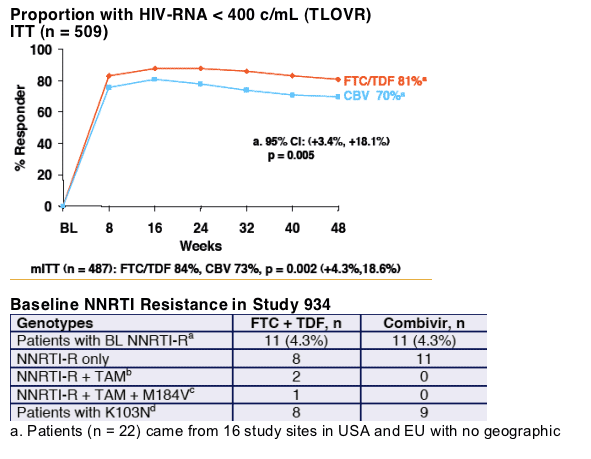
a. Patients (n = 22) came from 16 study sites in USA and EU with no geographic localization. Mean phenotypic susceptibilities to EFV, tenofovir, FTC, ZDV and 3TC at baseline were 28.6-fold reduced, 0.9-fold, > 4-fold reduced, 1.0-fold, and > 4-fold reduced (relative to wild-type), respectively. For patients without M184V at baseline (n = 21), mean phenotypic susceptibility to FTC and 3TC was 0.85-fold and 0.87-fold of wild-type, respectively. Three patients also had evidence of genotypic or phenotypic resistance to protease inhibitors.
b. Thymidine analogue mutations detected at baseline included M41L, D67N, K70R, K219Q, T215L/S.
c. No other patient entered the study with M184V/I and no patient had the K65R mutation at baseline.
d. K103N detected in 17 of 22 patients; other mutations included K101E, K103R, Y181C, Y188F, G190A/E.
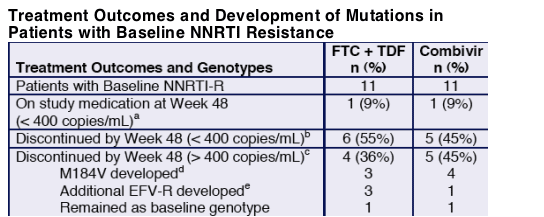
a. Two patients (8.4-fold and 29-fold reduced susceptibility to EFV) achieved < 50 copies/mL on study medication by Week 48.
b. Patients were lost to follow-up or switched medication due to baseline NNRTI resistance but were < 400 copies/mL at their last time point on study and were not genotyped.
c. Patients had confirmed > 400 copies/mL of HIV1 RNA while on study medication or after treatment switch and were genotyped. Compared to the mITT population, a significantly greater proportion of patients with baseline NNRTI-R (35/487, 7% vs 9/22, 41%) met resistance analysis criteria (p < 0.001, Fisher Exact Test).
d. No patient developed the K65R mutation. One FTC + TDF patient who had M41L and T215L mutations at baseline developed a mixture at codon 215 (T215C/F/R) with no effect on tenofovir susceptibility; the effect on FTC susceptibility could not be determined due to the concomitant development of the M184V mutation.
e. All four patients who developed more EFV-R mutations (L100I, V108I, Y188L, and P225H) also developed M184V.
Patients with Baseline NRTI Resistance only (n = 13)
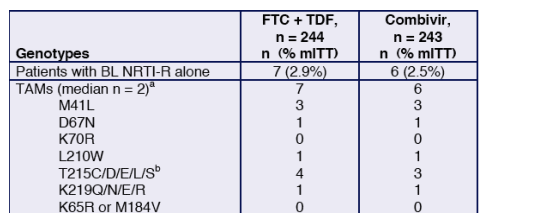
a. Two patients (8.4-fold and 29-fold reduced susceptibility to EFV) achieved < 50 copies/mL on study medication by Week 48.
b. Patients were lost to follow-up or switched medication due to baseline NNRTI resistance but were < 400 copies/mL at their last time point on study and were not genotyped.
c. Patients had confirmed > 400 copies/mL of HIV1 RNA while on study medication or after treatment switch and were genotyped. Compared to the mITT population, a significantly greater proportion of patients with baseline NNRTI-R (35/487, 7% vs 9/22, 41%) met resistance analysis criteria (p < 0.001, Fisher Exact Test).
d. No patient developed the K65R mutation. One FTC + TDF patient who had M41L and T215L mutations at baseline developed a mixture at codon 215 (T215C/F/R) with no effect on tenofovir susceptibility; the effect on FTC susceptibility could not be determined due to the concomitant development of the M184V mutation.
e. All four patients who developed more EFV-R mutations (L100I, V108I, Y188L, and P225H) also developed M184V.
By Week 48, all thirteen patients with baseline NRTI-resistance
mutations had remained on study medication:
--12/13 (92%) achieved < 400 copies/mL; 11/13 (85%) achieved
< 50 copies/mL.
--1 Combivir patient with baseline TAMs had virologic rebound.
Resistance Development at Week 48 (mITT, n = 487)
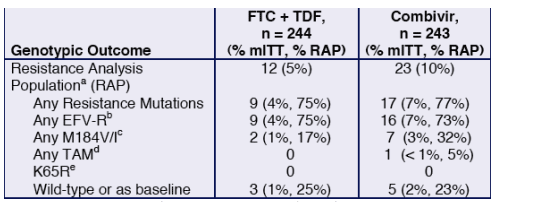
a. All patients with confirmed > 400 copies/mL of HIV RNA at Week 48 or early discontinuation analyzed. Patients with baseline NNRTI-resistance excluded (n = 22). Genotyping of 1 Combivir patient failed; % RAP for Combivir based on
n = 22 with available genotype.
b. K103N developed in 21/25 patients; other NNRTI mutations that developed included K101E, K103E, V108I/M, V179D, Y188H, G190A/S, P225H, M230L.
c. Both FTC + TDF patients and 6/7 Combivir patients that developed M184V also developed EFV-R mutations.
d. TAM = thymidine analogue mutations: M41L, D67N, K70R, L210W, T215Y/F, K219Q/E/R/N; TAM detected was K70K/R.
e. In addition, no K65R developed among patients with baseline NNRTI-resistance.
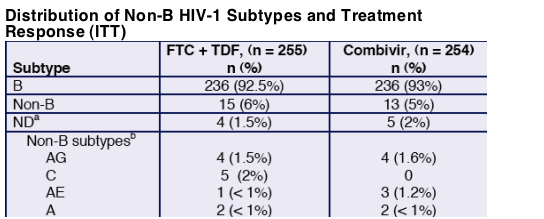
a. Sub-type could not be determined due to technical failure of baseline genotyping.
b. All others detected (BF, D, G and complex) were represented by ≦ 2 patients (< 1% of ITT population).
- All non-B HIV-1 isolates in both arms were considered wild-type at
baseline.
- By TLOVR, 87% of FTC + TDF and 69% of Combivir patients with
non-B HIV-1 were responders by Week 48 (p > 0.75 versus B
subtypes).
- No FTC + TDF patients with non-B subtype HIV-1 isolates met
resistance analysis criteria by Week 48.
- One Combivir patient (subtype AG isolate) met resistance analysis
criteria and developed EFV-R + M184V.
Low Rate of Tenofovir-Associated K65R Mutation Observed at Inner City Clinic
"NRTI Resistance in Relationship to K65R: a Study of Inner City HIV Patients who Present with Virological Failure"
In this poster at IAS-Rio (WePe4.4C20), H Fernandes reported the incidence of the K65R mutation at the University of Medicine and Dentistry of New Jersy (UMDNJ), which serves a large inner city population in Newark, NJ.
..... Inner city patients have multiple barriers to health care that might lead
to problems with adherence, thus making them more likely to develop
resistance to antiretroviral therapy....Over the period 2002 to 2004, despite a 10-fold increase in resistance mutations in patients on tenofovir and an increase observed in the presence of L74V mutation the incidence of K65R in patients with NRTI mutations remained relatively low....
Charts of all patients with K65R identified from Jan 2002 through
Dec 2004 were reviewed for past and concurrent antiretroviral therapy.
RESULTS
Over the evaluation period 2002 - 2004, 19 out of 572 patients with
NRTI mutations, had genotype specimens containing the K65R
mutation identified:
- NRTIs (number of patients) taken at any time were:
- TDF (17), ABC (12), ddI (13), AZT (13), d4T (11)
- Mean duration of NRTI therapy prior to first isolation of K65R was
8 yrs
- In 2004, the incidence of K65R in patients receiving various NRTIs and
who received resistance tests was:

Two patients were on AZT at the time K65R was identified
One isolate had both K65R and L74V
Overall Results
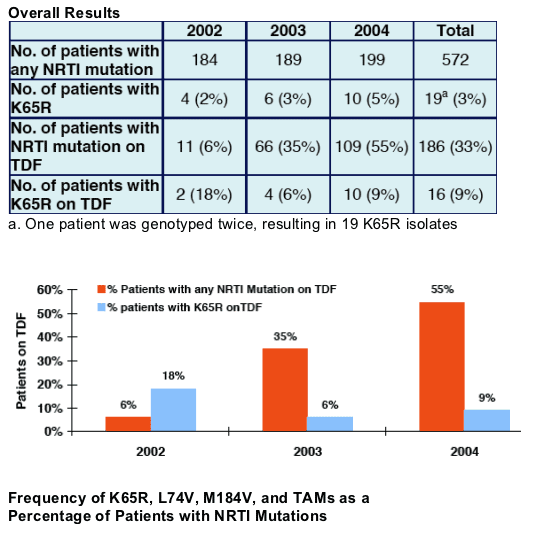
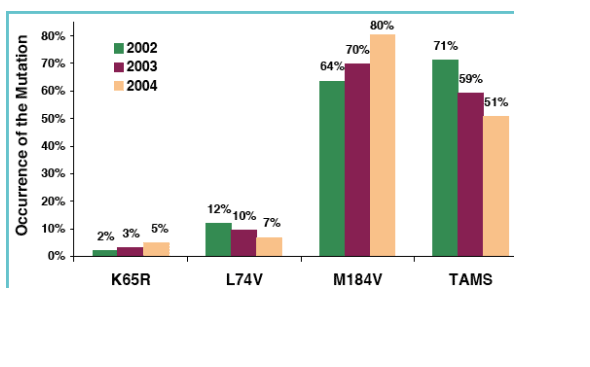
|
|
| |
|
 |
 |
|
|